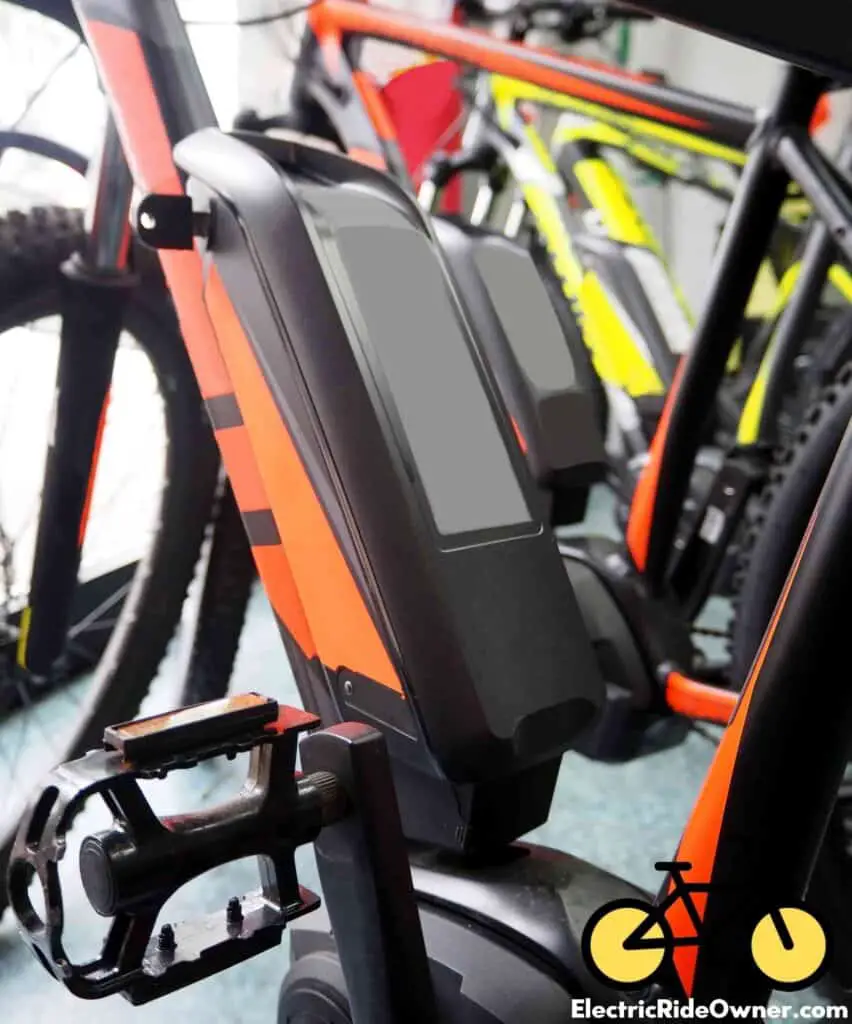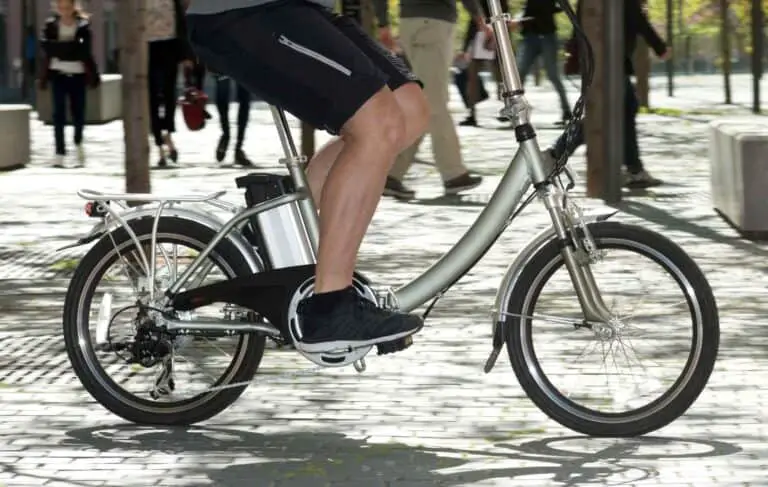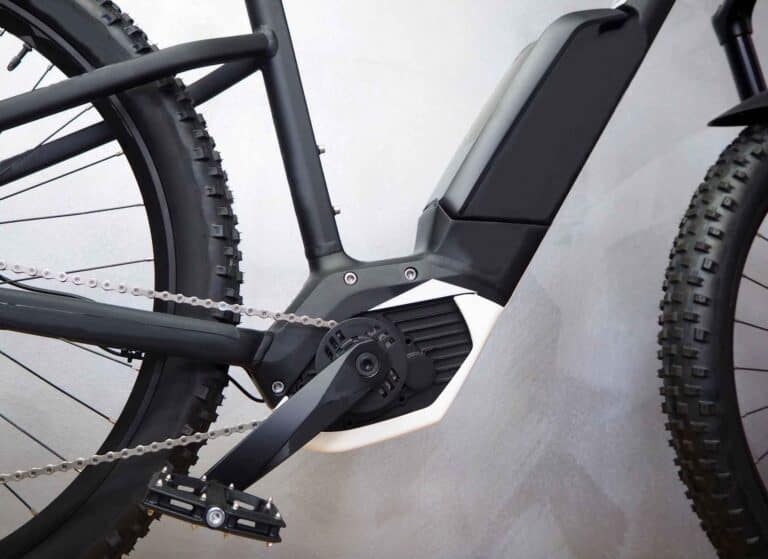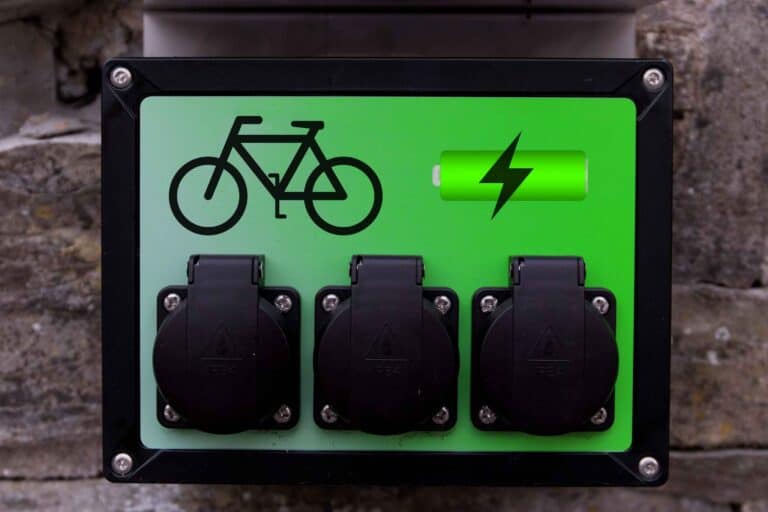Disadvantages of Electric Bikes You Wouldn’t Expect
I wanted to learn more about the disadvantages of electric bikes when I was preparing to purchase my first eBike. So, while I did my research, I compiled a detailed list of the disadvantages of owning an eBike, and I answered some questions prospective owners commonly ask about eBikes.
- Electric Bikes are heavy to ride with the motor off
- It is difficult to find places to charge eBike batteries on the go
- E-bikes have a costly initial investment
- Electric bike batteries need to be replaced multiple times (expensive)
- eBike batteries can have a short range
- Some eBikes are illegal in some states
- eBikes are targeted by thieves
- Many electrical malfunctions are possible with eBikes
- eBike Batteries take a while to recharge
1. Electric Bikes Are Heavy To Ride With the Motor Off
As a general rule, electric bikes weigh on average about 50 pounds. Because electric bikes are far heavier than standard bikes, if you choose to ride your electric bike with its motor turned off, your ride will feel much more difficult than normal.
Electric bikes can weigh anywhere from 40-70 pounds, depending on the type of eBike you have and how fat the tires are. If your eBike has fat tires, it will likely weigh close to 70 pounds. Some riders prefer to have fat tires, especially if they frequently ride their eBike on trails.
However, if your heavy fat tire eBike loses battery power in the middle of a ride or if you choose to ride it with the battery off, you will face a greater deal of resistance when compared to someone who has an electric bike outfitted with normal tires.
For some riders, the weight of an eBike could be a disadvantage. You may find it difficult to pedal without some degree of pedal-assist. Or, you may be hesitant to purchase an e-bike if you would have to carry it up and down your stairs each time you wanted to go for a ride.
While the weight of an eBike can be a disadvantage, there are lighter-weight eBikes available if the weight of an eBike is your only hesitation in purchasing an eBike.
If you would like to learn more about how much different electric bikes weigh, check out our article, “The Ultimate Electric Bike Weight Guide (31 eBike Examples).”
2. It Is Difficult To Find Places To Charge eBike Batteries on the Go
As a whole, there are not many accessible ways to charge your eBike battery on the go unless you have an alternate power source. Since e-bikes are not mainstream everywhere just yet, it is difficult to find an eBike charging station on the go.
If you live in an urban area, you may have more luck charging your eBike on the go, as there are eBike charging stations in most major cities in the United States, like in New York City, or Seattle, WA. However, for many eBike users, inaccessible means to charge on the go is a major disadvantage to owning an eBike. There are a few different ways you can charge your eBike battery on the go, but they aren’t as accessible as a charging station.
For example, you can charge your eBike battery through a 12V socket in a car (cigarette lighter), but if you do not have a car or if your eBike battery is not removable, this option is not accessible to you.
Using a power bank can help ensure that you have the option to charge your eBike battery when you’re on the go, as long as the current is larger than the wattage of the battery. So, if you have a 500W battery, you can use a 750W power bank, but not a 500W power bank to charge your electric bike battery. We recommend ordering this ApowKing HP500 power bank on Amazon.
For more information on how to charge your e-bike battery on the go, check out our article “Charging eBike on the Go (Car Battery, Inverter, Power Bank, Solar).”
3. E-bikes Have a Costly Initial Investment
On average, e-bikes are a costly investment. E-bikes can cost anywhere between $500 and $10,000 when purchased new. While e-bikes provide many advantages, this could be a barrier to entry for new e-bike riders.
E-bikes have a reputation for being quite expensive. While you are getting many luxurious features with your investment, like pedal assist and an all-around smooth ride, this is still a barrier to entry for many interested in purchasing an electric bike.
While the hefty initial cost may be a disadvantage, e-bikes can replace vehicles with a higher investment cost. Many users, especially in urban areas, choose to purchase an e-bike instead of a car. This leads to saving a lot of money on gas, insurance, parking, and maintenance. So, while the sticker price may be shocking, e-bikes can save you some money.
If you would like to learn more about how much electric bikes cost, feel free to check out our article, “How Much do Electric Bikes Cost? (Your Bottom Line)”
4. Electric Bike Batteries Need To Be Replaced Multiple Times (Expensive)
As a general rule, eBike batteries need to be replaced every three to five years. Electric bike batteries can be used for up to 10,000 miles, and most riders reach this limit within three years. The average cost of a replacement eBike battery is about $500 but ranges from $200 to $1,000.
On average, an eBike lasts about ten years. Given that information, you will have to replace your eBike battery at least once and maybe twice during the lifespan of your eBike.You would also have to replace your battery when you have ridden your eBike over 10,000 miles. The price of replacing your eBike battery once or twice in ten years can be a significant disadvantage for some riders, especially when tacked onto the cost of annual maintenance and the initial cost of your eBike.
A typical eBike battery costs about $500, but the higher the Wh, the more expensive the battery. In recent years, many big-name manufacturers have partnered with Bosch to equip their e-bikes with Bosch batteries, which are on the higher end as far as batteries cost. Most Bosch lithium-ion batteries cost about $800.
While you can replace your eBike battery with a different brand of battery than what it came with, we don’t recommend doing this. It is usually best to replace manufacturer parts with the same brand used by the manufacturer.
If you are looking for more information on electric bike batteries, check out our article “Electric Bike Battery Cost (A Helpful Chart).”

5. E-Bike Batteries Can Have a Short Range
As a general rule, eBike batteries can last anywhere from 25-100 miles on a single charge, depending on several factors such as weight, weather conditions, and terrain. However, this can be a disadvantage for some eBike riders who like to travel further than their e-bike’s given range.
A significant disadvantage for some prospective e-bike users is the short battery range. Most eBike batteries average about 30 miles on a single charge. If you would like to learn more about how long electric bike batteries last, check out our article, “How Long an Electric Bike Battery Last [Lifespan, Per Charge].”
Battery Range Depending on Weight
Your battery range can depend on how much weight you carry on your eBike. This means if you have a second passenger, like a child riding on a child seat, the weight of the second passenger can cause your motor to work harder, therefore draining your battery quicker than if there was just one person riding your eBike.
For more information on carrying a child on your eBike, check out our article “Electric Bike Child Seat Safety (Front Vs. Rear Vs. Trailer).”
Similarly, if you are a heavier person or if you are carrying cargo, your eBike motor will be working more, thus draining more power supply from your battery. So, the harder your eBike motor works, the more power it will need from your battery, which will decrease your battery’s range as it is working harder than usual.
Battery Range Depending on Weather Conditions
Your battery range will also depend on weather conditions. For example, if it is a particularly windy day and you are biking against the wind with your pedal-assist on, your motor will need to use more power from the battery, thus decreasing your battery range during your ride.
One way to save some battery during a windy ride is to ride with pedal-assist on a low level or turned completely off. You may face more resistance, but this will help you conserve your battery.
Battery Range Depending on Terrain and Trail Conditions
If you take your electric mountain bike out for a hilly ride, you may notice that your battery range is significantly less than when you ride on flat terrain. This is because if you use pedal-assist to ride on hills, riding uphill uses a significant amount of power from the motor and, thus, the battery.
To conserve battery power while riding on hilly terrain, try riding with your pedal-assist set at a lower level or turn it off completely. Your ride may be more challenging, but this will help you save some battery power.
6. Some eBikes Are Illegal in Some States
As a general rule, some eBikes are illegal in some states. The laws for e-bikes differ in each state and often depend on the maximum speed capability of your eBike. This can be a disadvantage for some eBike users who like to travel state to state with their eBikes or who like to ride at maximum speeds.
Many e-bikes are classified into a three-tier system, and states use this three-tier system to create laws for eBikes. In the three-tier system, e-bikes are classified as class one, class two, or class three e-bikes.
Class One E-Bikes
Class one e-bikes are classified by:
- Having a motor that only assists the rider when they pedal
- Pedal-assist that turns off when the e-bike reaches a speed of 20 mph
Class Two E-Bikes
Class two e-bikes are classified by:
- Having a motor that is only used to move the electric bike forward
- Having assist that turns off when the e-bike reaches a speed of 20 mph
Class Three E-Bikes
Class three e-bikes are classified by:
- Having a motor that only assists the rider when they pedal
- Having assist that turns off when the e-bike reaches 28 mph
- Having a speedometer

You will need to abide by the rules designated for the class which your e-bike falls under in your state. This classification system will determine where you are allowed to ride your e-bike (road vs. sidewalk), how fast you can ride your e-bike, and what type of licensure you will need to ride your e-bike, if any.
On top of some eBikes being illegal in certain states, e-bikes need to be registered in some states. For specific information on how to register your eBike in your state, check out our article titled “Are Electric Bikes Street Legal (Detailed Info: All 50 States).”
7. eBikes Are Targeted by Thieves
On average, the high cost of electric bikes makes them a target for thieves. If you live in an area where e-bikes often get stolen or if you do not have a secure area to store your electric bike while you are not riding it, it could end up being targeted by thieves or stolen.
According to bikeindex.org, a user-run bike registry index, there are thousands of reported eBikes across the United States. While eBikes are no easier or harder to steal than standard bikes, they are more valuable and have more resale value.
We recommend registering your eBike with both bikeindex.org and your manufacturer’s online registry if it is available. Registering your e-bike can become a helpful tool if your eBike does get stolen because you can prove your ownership to authorities and your eBike’s manufacturer.
To ensure your eBike is not stolen, you should always lock your eBike when you leave it unattended. We recommend this anti-smash, cut, and saw combination lock from CYCLESPEED, which is available on Amazon.
For more information on storing your eBike safely, check out our article “17 Electric Bike Storage Ideas You Can Actually Use (Home, Garage, Outside).”
8. Many Electrical Malfunctions Are Possible With eBikes
As a whole, the possibility of an electrical malfunction can be a disadvantage of using an eBike. As electric bike technology gets better, common malfunctions are corrected, but many electrical malfunctions are still possible.
Electric bikes manufacturers have yet to reach their peak in their respective technologies. While eBikes have come a long way since they first entered the mainstream market in the early 2010s, each year, the technology advances. Because eBike technology is still developing, there are several possible malfunctions that can occur during the duration of your eBike ownership.
E-bikes have intricate electrical systems that can easily overheat if they are not kept in the right conditions, which can cause your eBike to cut out while you are riding it or several other issues while it is not in use. It is important to consistently take your eBike for annual or bi-annual tune-ups to ensure a small electrical malfunction does not turn into a larger problem.
If you want to avoid as many malfunctions as possible, it is important to store your eBike properly and, most importantly, protect it from any exposure to water. For more information about waterproofing your eBike, check out our article “How to Waterproof Your eBike (Avoid This Mistake).”
9. eBike Batteries Take a While To Recharge
On average, eBike batteries can take anywhere from three to seven hours to charge. This can be a disadvantage if you are out riding your eBike and its battery dies. Unless you have several hours to wait for the battery to recharge, you may have to ride your eBike manually until you reach a power source.
Most eBike batteries take about 4.5 hours to charge, but the charging time can range depending on the Watt Hour (Wh) capacity and Voltage (V) of your battery. If your electric bike battery is only 100Wh, it will probably take an hour or less to charge. That being said, you won’t be able to go very far on a fully charged 100Wh battery, so you may have to charge it several times if you are going for a long ride.
In contrast, if you have a 950Wh battery, it may take up to seven hours to charge completely, but you will be able to get quite a bit of riding time out of a single charge.
E-bike batteries that take a while to charge may be disadvantageous because it is not recommended to leave your eBike battery on a charger overnight, as this will decrease its battery capacity over time.
If you would like to learn more about how long e-bike batteries take to charge and the best charging practices to abide by, take a look at our resource, “How Long Does An Electric Bike Battery Take to Charge.”
Some things are worth waiting for, like charging your eBike battery.
-Electric Ride Owner
Do Electric Bikes Have Problems?
As a whole, electric bikes do have problems. They are expensive, require expensive replacement parts, and can malfunction in several different ways. While electric bikes do have problems, it is important to note that they also have a lot of redeeming qualities, like its cost when compared to other electric vehicles.
Like any gadget, electric bikes can have electrical malfunctions. There are several things that can go wrong with your eBike, specifically with its battery. When an eBike is not well maintained, it is more likely to malfunction. If you store your eBike in a dry, mild environment, clean it after riding on loose dirt or gravel, and take it for annual or bi-annual tune-ups, you may be able to avoid major malfunctions in the early stages of owning your eBike.
E-bike batteries can cut out for several reasons. You may need to replace your charger every now and again, you may need to replace some cells in your battery, or you may experience issues with your battery management system (BMS). If your eBike cuts out, check out our article “E-Bike Battery Problems (A Fix that Actually Works)” for multiple ways to troubleshoot your battery issues.
Other parts of your eBike, like its motor or controller, can malfunction and cause problems. Sometimes the fix is as easy as plugging in a loose connection or as costly as replacing the motor. Generally, if you keep your e-bike well maintained, you should not experience these problems.
Another way to avoid problems with your electric bike is to waterproof it. Most eBike motors and batteries are waterproofed during manufacturing. If you live in a humid or wet climate, it might be a good idea to take extra steps to waterproof your eBike so you can avoid issues caused by water exposure. For more information on how to waterproof your eBike, check out our article “How To Waterproof Your eBike (Avoid This Mistake).”
Why Should I Not Buy an Electric Bike?
In total, if you live in a small area, cannot lift or pedal at least 50 pounds, or do not have access to a power source or electricity, you should not buy an electric bike. There are several barriers to entry when it comes to eBikes, not to mention the substantial initial investment cost.
When thinking about purchasing an eBike, you should consider the environment in which you live, how much use you will get out of it, and if you will be able to afford its maintenance.
Environments in Which Electric Bikes Are Not Suitable
If you live in an area designed for transportation via cars, you may have a hard time riding your eBike. It can be dangerous to ride an e-bike on the road if the roads where you live are not designed for bikers.
If you live in a small apartment or in a space in which you do not have a dry, mild environment to store your eBike, an eBike may not be for you. For example, if you live in a small apartment without a garage, you may find it to be difficult to store your eBike when you are not riding it, especially long-term like during the winter.
Similarly, if you live in an apartment without an elevator, it may be difficult to take your eBike up and down the stairs every time you want to go for a ride, as most eBikes weigh about 50 pounds.
Financial Barriers to Electric Bikes
While you might be able to afford the initial cost of an electric bike, you will want to figure out if you will be able to afford the costs of maintaining your eBike. Generally, you should take your eBike for a tune-up each year, if not twice a year. A tune-up for an electric bike in most areas is at least $150.
After about three years of consistent use, you will need to replace your battery. Typically, eBike batteries cost about $500 or higher. If you properly maintain your eBike, it should last for about five years, so you will need to replace the battery at least twice, and maybe even three times. Additionally, you will need to make sure you can afford any other repairs or replacement parts your eBike may need.
You should also consider the cost of charging your eBike battery. To see a breakdown of how much you will spend each time you charge your eBike, check out our article “Electric Bike Vs. Gas Bike (An Expert Weighs Pros and Cons),” where we explain how to calculate the cost of charging your eBike battery.
How Long Do Electric Bikes Last?
On average, electric bikes last about ten years before the quality begins to decline rapidly. You can ensure your eBike will last as long as possible by storing it properly in a dry, mild environment.
With proper maintenance, eBikes can last up to ten years. After ten years of consistent use, the larger parts like the motor and the controller may need to be replaced, making it more cost-efficient to purchase a new eBike. Since eBike technology changes each year, it is best to replace yours after ten years to stay up to date with the latest advancements.
If you would like more information about the lifespan of an eBike, check out our article “How Long Does an Electric Bike Last (an Expert Weighs in).”
Are Electric Bicycles Worth Buying?
As a whole, if you believe you will get your money’s worth of use out of an electric bike, it is worth buying. If you live in an urban environment and are looking to replace a car, an electric bike will save you a lot of money, thus making it worth the investment.
While there are some disadvantages to purchasing and owning an eBike, there are also several advantages. For starters, if you live in an urban area that has the infrastructure to support safe cycling, an electric bike can easily replace a car or another mode of transportation.
If you are riding your eBike to replace a car, you will be saving a lot of money at the initial cost of purchase, and you will not need to purchase insurance. Plus, it is almost always less expensive to power a vehicle using electricity instead of gas.
If you think you will get good use out of an electric bike, we highly recommend purchasing one. Even if you live in a suburban or rural area, there are plenty of parks or sidewalks on which you can ride your eBike.
Why Are Electric Bikes Not Popular?
On average, electric bikes are not popular because there are still several barriers to entry to owning an electric bike. They are expensive and large, and many cities in the United States do not have the infrastructure to support electric bike riders.
In big cities like New York or Los Angeles, eBikes are very popular. Part of this is because cities have the infrastructure to support cyclists, and the other part of this is because it is very expensive to own and park a car in big cities. In big cities, there is more access to charging stations, and many offices offer secure parking for eBikes.
On the other hand, eBikes are not as popular in suburban or rural areas because these areas lack the infrastructure to support cyclers. Plus, there is not as much access to public charging stations in these areas, and many people do not live close enough to their jobs to use their eBikes to commute.
Another reason eBikes are not popular is that they are expensive. The cost of an eBike is a significant barrier to entry for many potential owners, thus making eBikes less popular.
Are Electric Bikes Safe?
As a general rule, electric bikes are safe. As long as you are properly maintaining your eBike and keeping it away from water exposure, your electric bike should be safe to use. We urge every electric bike rider to wear a helmet to maximize their safety when riding.
You must also commit to maintaining your eBike to ensure its safety. It is not recommended to ride your e-bike in significantly wet conditions because you can expose yourself to the risk of electrocution. It is very important to make sure you are maintaining your eBike by keeping it in a dry and mild environment to avoid any major malfunctions while you ride.
E-bikes are no more or less safe than standard bikes. As long as you know how to ride a bike, wear a helmet, and are aware of your surroundings, riding an electric bike is safe. Depending on where you live, it may not be safe or permissible to ride an electric bike in the street or on the sidewalk, so make sure you check the laws in your state regarding eBike usage.
You can also check out our article titled “Are Electric Bikes Street Legal (Detailed Info: All 50 States).”








